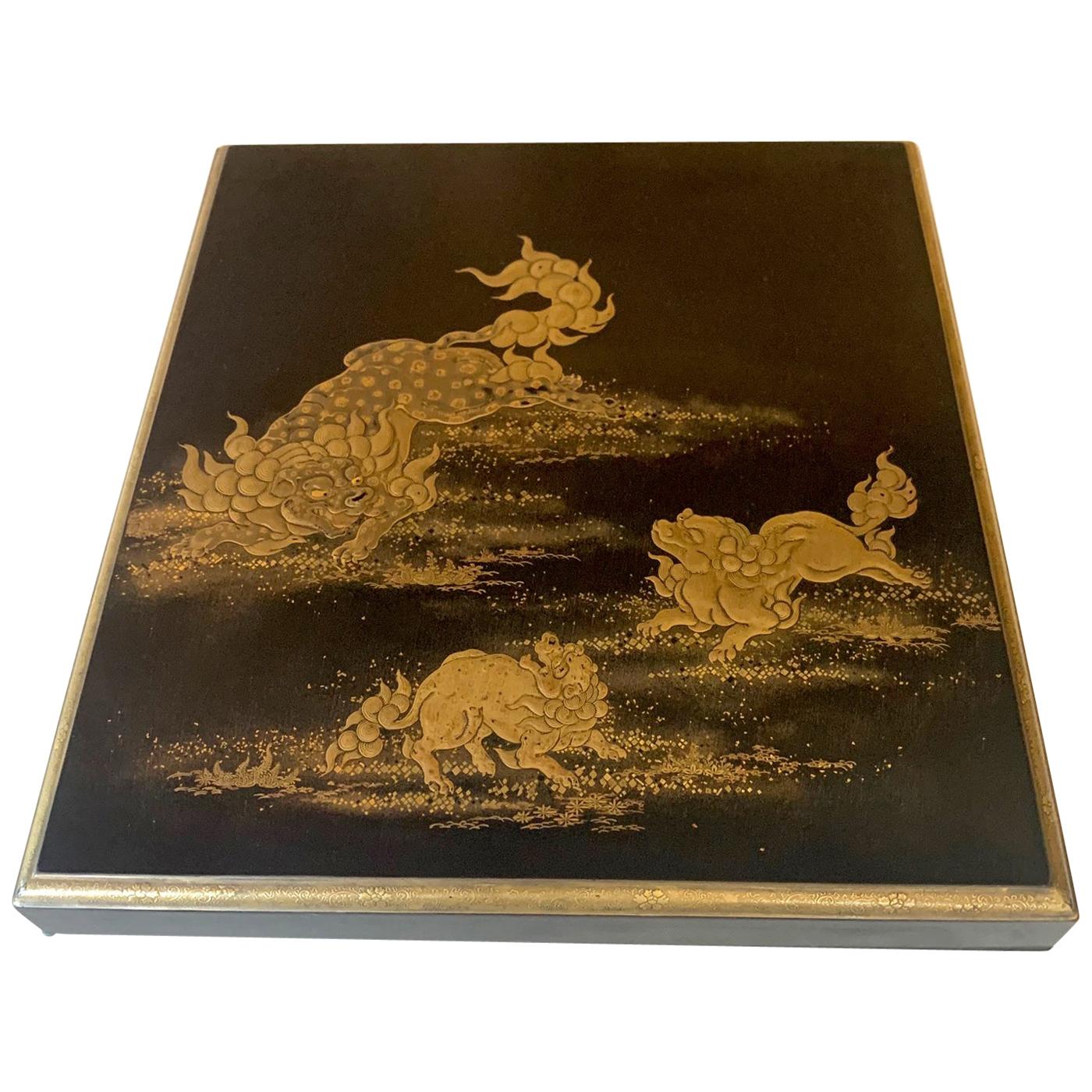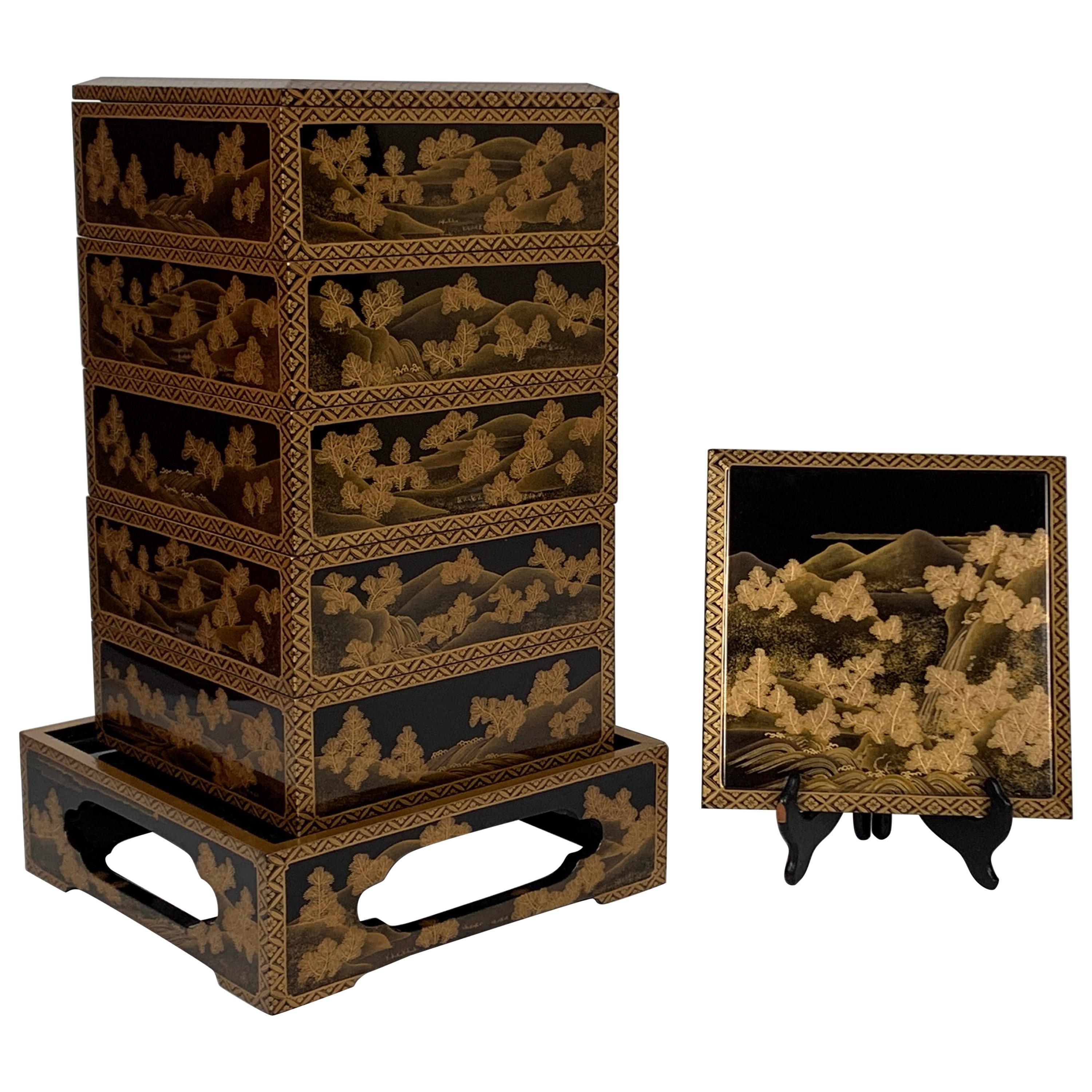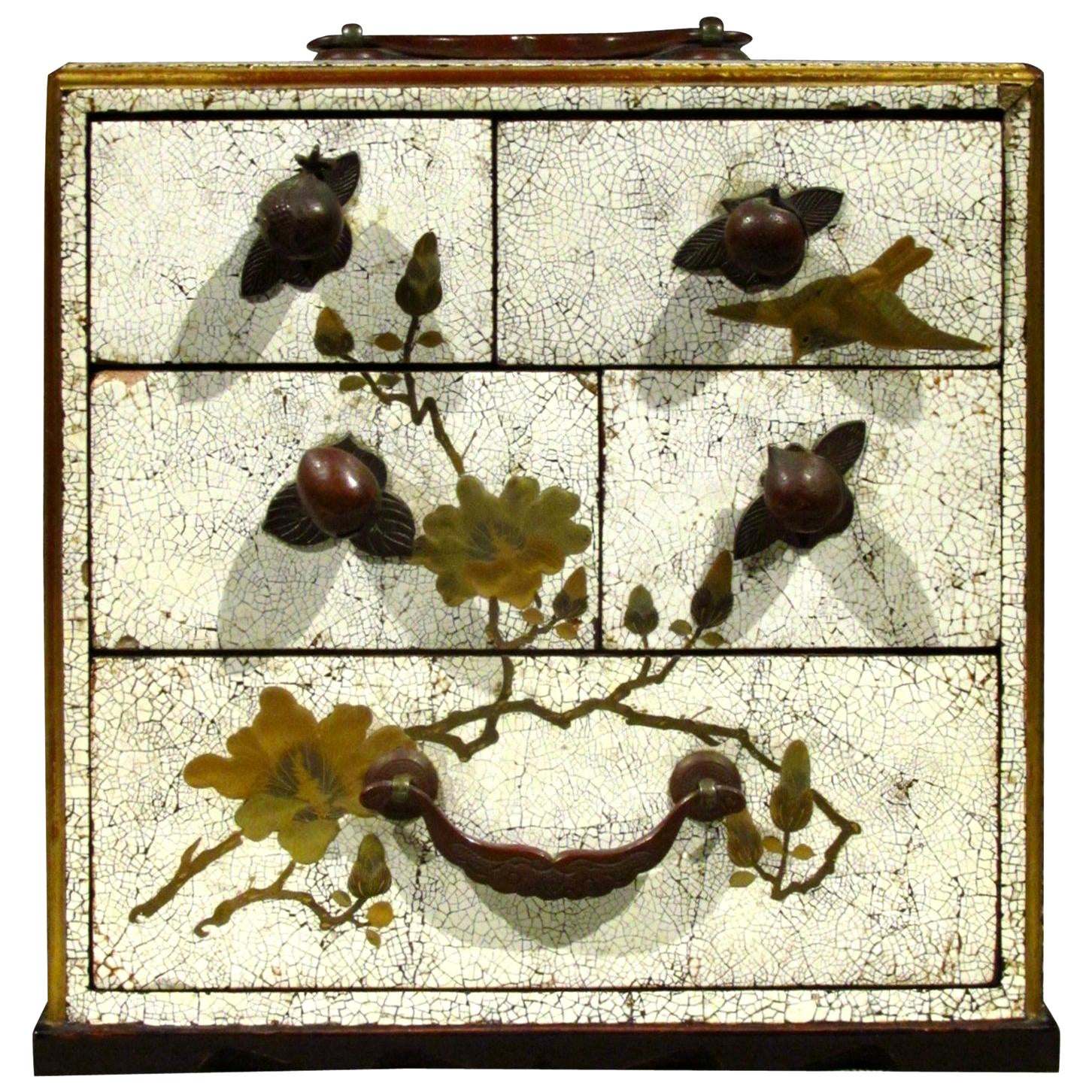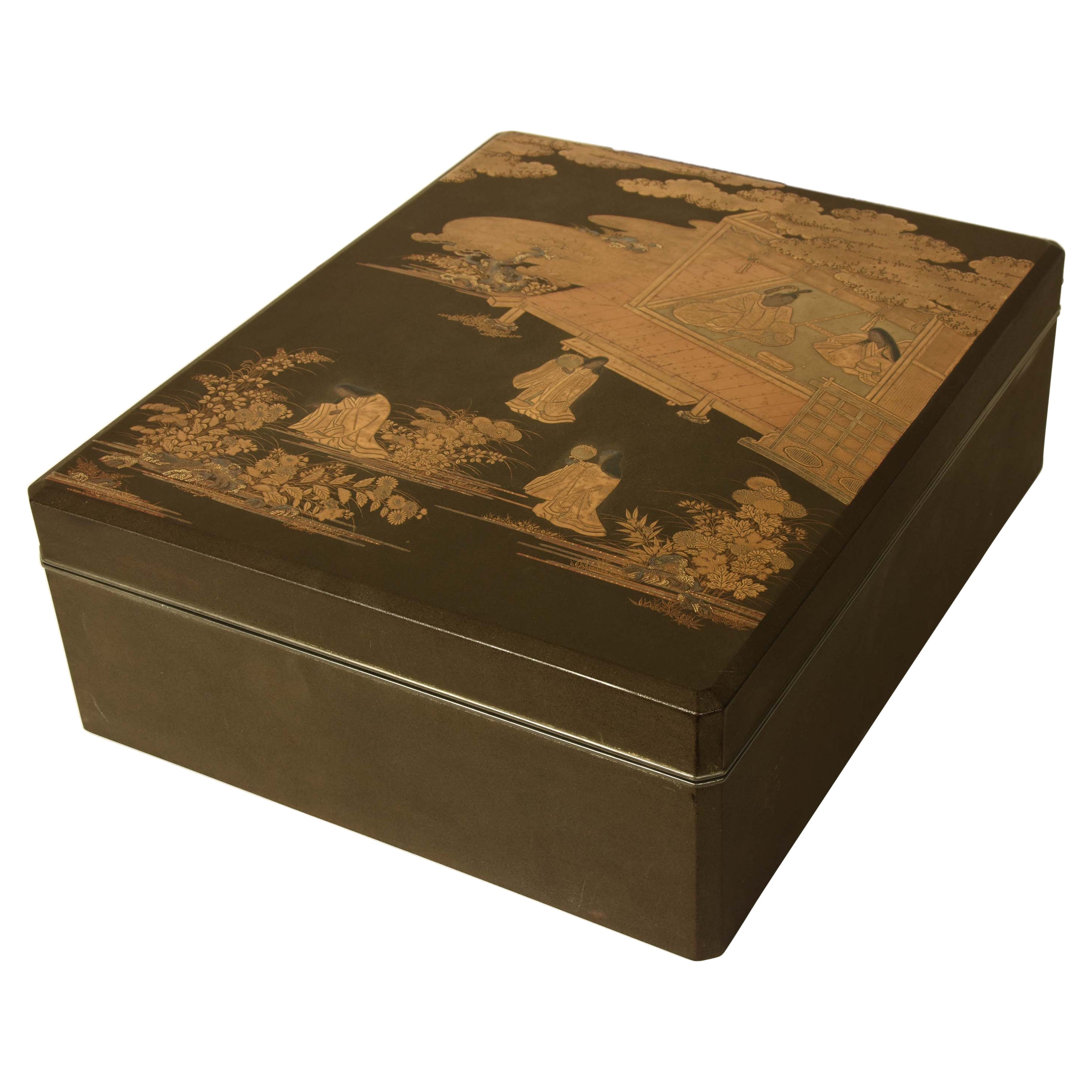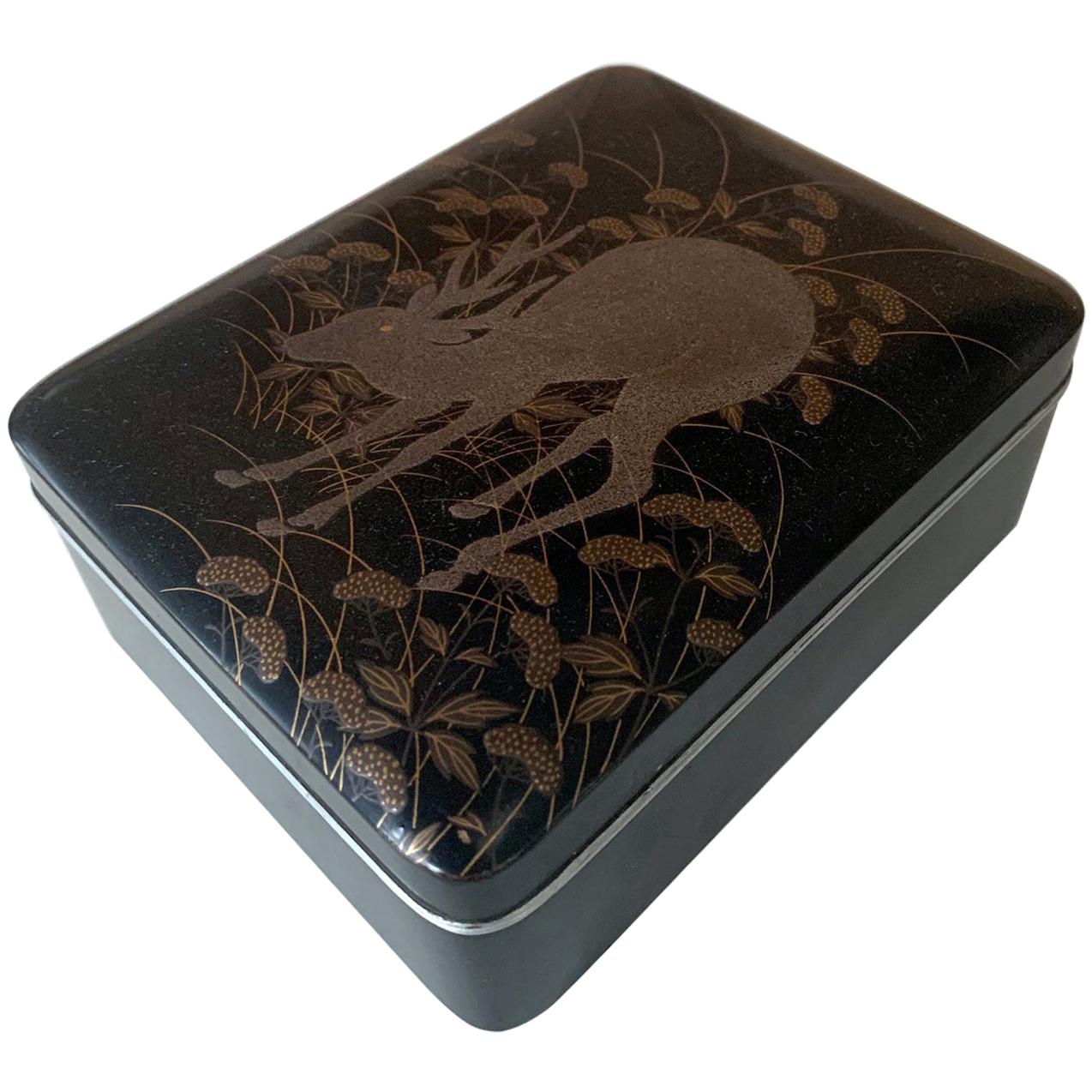Items Similar to Japanese Lacquer Maki-e Sake Ewer Meiji Period
Want more images or videos?
Request additional images or videos from the seller
1 of 16
Japanese Lacquer Maki-e Sake Ewer Meiji Period
About the Item
A Japanese lacquered wood sake ewer with maki-e design, circa late 19th century, Meiji period. The nicely decorated lacquerware is of a Classic sake ewer form with a round body, a small short sprout, a highly raised handle and three small supporting feet on the base. The surface is of a deep mellow brown color and decorated beautifully in hiramakie with an assortment of garments, samurai arm and helmet, accessories, all among the floral arrangements. Silver maki-e was scattered across the design to compliment the general gold palette. The handle was decorated with gold scrolling vines among cloud pattern. The interior of the ewer was finished in a dense nashiji. This type of sake ewer was normally reserved for special occasions in the aristocratic families and not for daily use.
- Dimensions:Height: 7.5 in (19.05 cm)Width: 7.5 in (19.05 cm)Depth: 5.5 in (13.97 cm)
- Style:Japonisme (Of the Period)
- Materials and Techniques:
- Place of Origin:
- Period:
- Date of Manufacture:1890s-1900s
- Condition:Repaired: the crack mentioned appears to have been repaired historically and the surface was re-lacquered with maki-e. Wear consistent with age and use. Fine overall, two small scrub marks on the rim, a crack on the side as shown that seems to have been somewhat restored, the lid doesn't fit perfectly due to a slight warp in shape.
- Seller Location:Atlanta, GA
- Reference Number:1stDibs: LU945022461292
About the Seller
5.0
Platinum Seller
These expertly vetted sellers are 1stDibs' most experienced sellers and are rated highest by our customers.
Established in 2006
1stDibs seller since 2010
486 sales on 1stDibs
Typical response time: <1 hour
- ShippingRetrieving quote...Ships From: Atlanta, GA
- Return PolicyA return for this item may be initiated within 2 days of delivery.
More From This SellerView All
- Japanese Lacquer Box with Fine Maki-e Decoration Meiji PeriodLocated in Atlanta, GAA lacquered wood box with lid from Japan circa 19th century Meiji Period. The finely decorated box was used to store paper slips and small documents on the desk. It is overall finished with black lacquer (kuro) with sparse Mura-Nashiji effect outside and on the top surface of the lid, there are three Komainu, (sometimes known as Shishi or Japanese lions) frolicking and forming a circle in lively motion. Komainu are auspicious animals in Japanese cultures in both Shinto and Buddhism tradition. Originally from China, these animals symbolizes guardians to ward off evil spirits. Hiramaki-e was used in combination with carving and combing to render the lions with various surface textures. A gilt border with an slight angle was given to the lid and even the thin band is decorated with miniature floral scrolls. The interior of the box was finished in a dense nashiji. Underneath the lid, a cluster of peonies open lavishly by two gentle mounts. Takamaki-e (high relief) in both gold and silver were...Category
Antique Late 19th Century Japanese Japonisme Lacquer
MaterialsWood, Lacquer
- Japanese Rinpa Style Lacquer Box Meiji PeriodLocated in Atlanta, GAA black lacquer tebako (hand box) with maki-e decoration and silver trim, circa late 19th century, Meiji period. The surface of the lid features a Rinpa style maki-e paint depicting ...Category
Antique 1890s Japanese Japonisme Lacquer
MaterialsWood, Lacquer
- Japanese Lacquer Ryoshibako Document Box Meiji PeriodLocated in Atlanta, GAA large Japanese lacquer box with elaborate Maki-e design from Meiji period, (mid-late 19th century). The generous size of the box was reser...Category
Antique 19th Century Japanese Japonisme Lacquer
MaterialsWood, Lacquer
- Rare Japanese Lacquer Writing Box Suzuribako Meiji PeriodLocated in Atlanta, GAA Japanese Lacquer writing box Suzuribako Meiji Period (1868-1912), likely circa late 19th century. This suzuribako is one of the most unusual boxe...Category
Antique 19th Century Japanese Japonisme Lacquer
MaterialsLacquer
- Japanese Maki-e Lacquer Stack Box JubakoLocated in Atlanta, GAAn antique jubako (stack boxes) with five tiers in an elongated octagon shape circa 19th century (end of Edo or beginning of Meiji period). jubako was traditionally used to store and...Category
Antique 19th Century Japanese Japonisme Lacquer
MaterialsWood, Lacquer
- Exquisite Japanese Lacquer Maki-e Hand Box Kobako Edo PeriodLocated in Atlanta, GAAn early Japanese lacquer Maki-e decorated kobako (small storage box) circa 18th century (Edo period). Based on its form and size, this kobako was possibly used as a Chabako to store the accoutrements for chado (tea ceremony). The lidded box is of rectangular form with bevel design on all edge that softens the appearance. The entire surface was densely covered with a background of nashiji. Elaborate Maki-e techniques were used on each side to showcase a distinct landscape or floral design within a cartouche panel. On the surface of the lid, a mountainous landscape rises from the edge of the water. The poetic composition is akin to a traditional ink scroll...Category
Antique 18th Century Japanese Edo Lacquer
MaterialsLacquer
You May Also Like
- Japanese Maki-e Lacquer Stacking Box, Jubako, Meiji Period, JapanLocated in Austin, TXA fine and impressive Japanese gold maki-e decorated black lacquer five-tier jubako with presentation tray, two lids, and the original tomobako storage box, Meiji period, late 19th c...Category
Antique Late 19th Century Japanese Meiji Lacquer
MaterialsLacquer
- Signed Japanese White Lacquer and Maki-E Lacquer Tansu, Meiji PeriodLocated in Ottawa, OntarioThe case decorated overall in crackle-glaze white lacquer and fitted with a patinated metal carrying handle over three tiers of small drawers. The first two tiers are comprised of a ...Category
Antique Late 19th Century Japanese Meiji Lacquer
MaterialsLacquer
- Japanese Meiji Period Antique Lacquer Box with Gold Maki-e DecorationLocated in New York, NYA fine antique Japanese Meji Period lacquer box decorated with a fan and a stylized star shaped window in the maki-e technique. The fan at the top right corner, fully opened depictin...Category
Antique 19th Century Japanese Meiji Lacquer
MaterialsLacquer
- Japanese Black Lacquer Document Box with Gold Maki e Design, Meiji PeriodLocated in Prahran, VictoriaAn antique black lacquer document box with an exquisitely detailed, finely wrought design from The Tale of the Genji depicted in gold maki e across the lid. Internally, the box is de...Category
Early 20th Century Japanese Lacquer
MaterialsWood, Lacquer
- Japanese Lacquer House Shaped Incense Box, Kogo, Meiji Period, JapanLocated in Austin, TXA delightful and intricately decorated lacquer box for storing incense, kogo, in the form of a traditional farm house, Meiji period (1864 - 1912), late 19th century, Japan. The kogo, or small box for storing incense, takes the whimsical form of a traditional Japanese home, minka, with the removable high, thatched roof serving as the cover for the box. The exterior of the home has been painstakingly decorated in maki-e lacquer against a matte black lacquer ground. Traditional shoji doors, bamboo blinds...Category
Antique Late 19th Century Japanese Meiji Lacquer
MaterialsLacquer
- Japanese Marquetry and Lacquer Jewelry Chest, Meiji Period, circa 1900, JapanLocated in Austin, TXA very attractive Japanese wood table top jewelry or collector's chest with marquetry and lacquer decoration, Meiji period, circa 1900, Japan. Previously in the collection of Asbjorn Lunde (1927 - 2017). The chest is crafted in the form of a Chinese seal...Category
Antique Early 1900s Japanese Meiji Lacquer
MaterialsWood, Softwood, Lacquer
Recently Viewed
View AllMore Ways To Browse
Black Lacquered Furniture
Black Lacquer Furniture
Black Lacquer Design
Lacquer On Wood
Black Gold Lacquer
Gold And Black Lacquer
Antique Floral Arrangements
Japanese Antique Lacquer
Japanese Black Lacquer
Japanese Clouds
Black Lacquer Asian Art
Round Black Lacquered Wood
Black Lacquer With Gold Art
Japanese Lacquer Gold
Ewers
Japanese 19th Century Lacquer
Antique Ewer
Japanese Samurai Art
